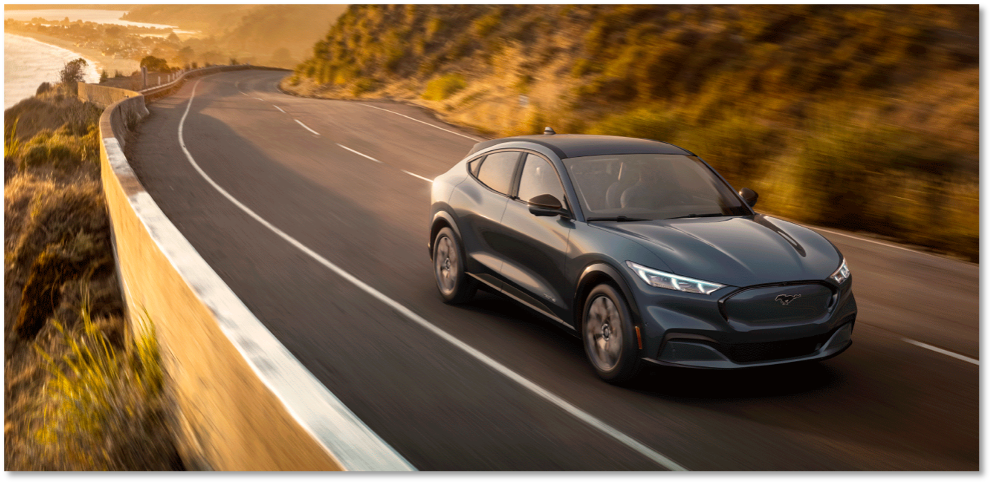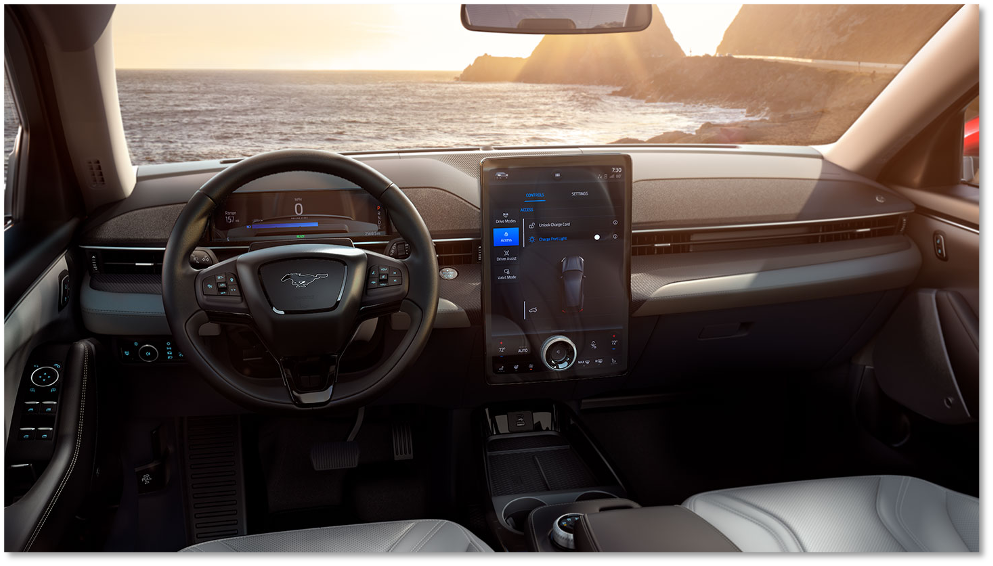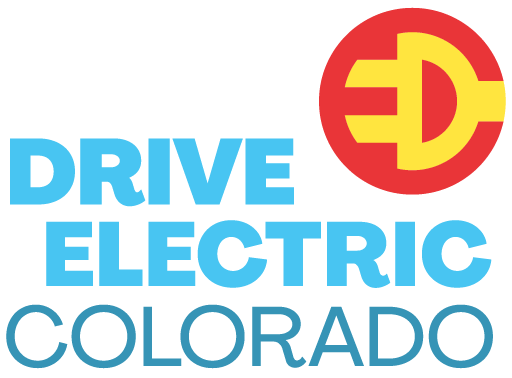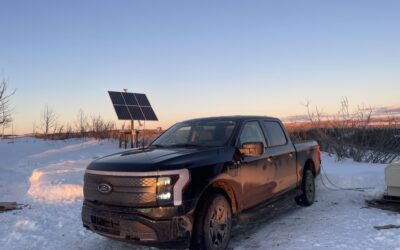Ford Mustang Mach‑E First Observations

By: Rob Bowers
On December 15th, I visited the Phil Long Ford location in Motor City, Colorado Springs with an appointment to experience the upcoming Mach‑E. While waiting for my turn, I spent about 20 minutes chewing the fat with former Broncos player Randy Gradishar and reminisced about some common acquaintances.
I was greeted by a Ford Marketing representative from Michigan who proceeded to introduce me to an “Infinite Blue” (stock picture above) Premium model in the showroom. I was very open about comparisons between Ford and Chevy features, including the 360-degree view (both Bolt and Mach‑e share this feature), Rearview camera (Bolt only), and comfort (Mach‑e is significantly more comfortable with ample soft-touch surfaces).
Sitting in the back seat, I felt the headroom was adequate for a 6‑foot guy, but it had a bit less legroom than the Bolt. The roofline is black, with a panoramic glass roof extending the full passenger area of the cabin, but side pillar features follow a fastback style much like earlier Mustangs. The result is clearly a sporty looking design, with interior space somewhat similar to a CUV. I would call it a compromise, not necessarily a negative. There is no internal cover for the panoramic roof. This may be distracting to some drivers on sunny days, though the double thickness and tinting may somewhat compensate for the excess light entering the cabin during daylight hours.
The car is equipped with an unlock button on all four passenger doors, similar to a power button on a PC. The key fob seems useless, though I suspect the presence of the Fob and/or a paired phone with the FordPass app are necessary for the unlock buttons to activate. When pressed, the door opens about 3 inches. A U‑shaped grip is outfitted on the front doors which can be used to open the door fully, but for the rear doors, a rubber grip on the inside is used instead. This scheme no doubt allows for an aerodynamic benefit. I can’t help but wonder why the rear door method wasn’t used for the front as the handle seems a bit unnecessary.

While in the initial open state, the door cannot be closed without first opening the door fully, thus protecting fingers from inadvertently being slammed in the door. A nice touch, kind of unique. I can’t help but wonder if ice build up might compromise the door button functionality, however the accompanying smartphone app enables remote door lock and unlock as well as remote window control.
The FordPass app allows for an extensive list of remote features including lock, unlock, windows, charging settings, remote start, routing, and other vehicle settings.
Ford has partnered with Electrify America and provides 250 kWh of complimentary EA Quick Charging. Plug & Charge is fully supported on networks that have implemented this feature.
The rear hatch can be opened by waving your foot under a sensor, provided your paired phone or key fob is within range. The rear cargo area is a decent size, with a convenient two-level deck. At the high level, with back seats folded forward, the cargo space is quite generous and provides a flat surface. With the deck in the lower position, an additional 3” of depth are possible. Underneath the deck is a cutout where the 120V240V mobile charge cord is stored, as well as a tire inflator kit which apparently comes standard.
Under the hood is a large cargo trunk, outfitted with a divider which attaches with a few screws. Converting from a compartmentalized trunk to a large space would require tools, but not too difficult. It seals when the hood is closed and could conceivably be used as a large ice chest for a tailgate party.
In the driver’s seat, the seats are a faux leather material, which hold true for all trim levels, with color options varying by trim. The seats are quite comfortable with common electronic controls. Configurable driver profiles will remember mirror and seat settings when the smartphone connects to the infotainment system. Other profile controls can be configured through the phone app and Infotainment screen, including climate controls. An online video suggests that the range estimate on the small Driver Info Center screen (DIC) will adapt to the driver profile that is active at the time. So, in a two-driver household, the lead foot will see a lower range estimate than the feather foot.
A high-end B&O sound system option equips the entire front edge of the dashboard with a continuous mesh speaker covering. I suspect this will be a bit of a challenge for auto detailers to keep clean. The upper dash is hard touch, but mostly out of reach to the passengers. The lower portions of the dash facing the passengers uses a soft touch material. The massive 15.5” portrait-oriented infotainment touchscreen contains a variety of software settings and alternate views. The lower portion of the screen has a dedicated bar with climate control buttons that persist whatever upper screen views the driver selects. There is a large volume dial in the lower center of the screen that almost seems out of place.


In front of the driver are two more small screens. One is attached to the dash and contains speed and range data. Presumably, the display can be changed through steering wheel controls, but I did not explore this. This may be an attempt to appease drivers who dislike Tesla’s lack of driver dedicated displays, giving a more traditional feel to the driver. Other driver controls such as power button, wipers, and on wheel phone, cruise and entertainment controls retain the traditional feel drivers are accustomed to.
The second, rather inconspicuous screen is fixed to the steering column and is apparently fitted with cameras for the yet to be released ADAS system. Online videos suggest these will be used to detect whether the driver is looking forward, a pre-requisite to driver assist functionality.
Wireless charging and wireless Android Auto or Car Play are standard features. The charging mat is on the driver side of the console, towards the front of the center console. The drive selector dial sits in the middle of the center console and there is a decent amount of storage in the console.
There are three drive modes: Whisper, Engage and Unbridled. These adjust regen and peddle sensitivity. In keeping with the Mustang breed, Unbridled is a performance setting with increased responsiveness and artificial sounds to give the illusion of being in a “Muscle Car”.
The battery options are a 68kWh and 88kWh usable capacity. The actual capacity is roughly 72 and 95kWh. Ford reserves a portion of the capacity to preserve pack health.
Range will vary depending on model and drive options with a rear-wheel or all-wheel drive option impacting range. EPA estimates for the standard range (68 kWh) configuration across all trims:
- 211 (AWD)
- 230 (RWD)
The Extended Range (88kWh) option will provide EPA validated ranges of 235 – 300 miles depending on model.
- 300 miles for the Premium and California Route 1 RWD trims.
- 270 miles for the AWD Premium and First Edition.
- 250 miles for the GT AWD trim.
- 230 miles for the GT AWD Performance Edition.
DC Charging is up to 115 kW (Select trim) or 150 kW (all other trims). Reports are the charging curve is relatively flat up to 80% and remains somewhat high for the remainder. Overall, this should make for a good road trip EV, particularly when the ADAS features are unlocked.
Overall, this car retains many of the unique Mustang breed characteristics. While some traditionalists may take exception to an SUV styled Mustang, the signature vertical rear light bars and familiar Pony emblems are present, albeit with modern sequential motions more common with current vehicles in the market.
Pricing starts at $43,000 for the Select, $47,000 for the Premium, $50,000 for the Route 1, and $61,000 for the GT. Obviously, options will drive prices higher, but the Mustangs will qualify for the $7,500 Federal, and $2,500 CO tax incentives, making the net prices roughly $31,500 to $49,500. All of the models are available now with the exception of the GTs which will arrive mid-year 2021.




